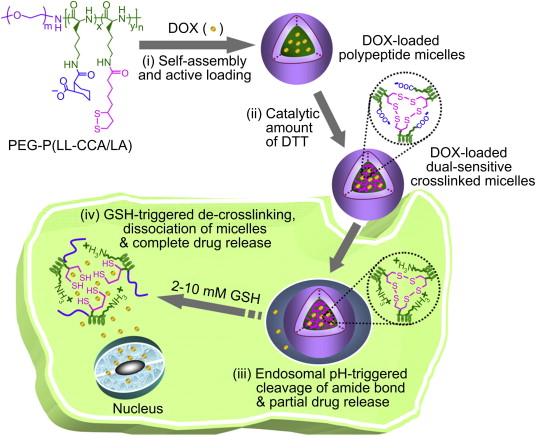Liangliang Wu, Yan Zou, Chao Deng*(邓超), Ru Cheng, Fenghua Meng, Zhiyuan Zhong*(钟志远)
Biomedical Polymers Laboratory, and Jiangsu Key Laboratory of Advanced Functional Polymer Design and Application, College of Chemistry, Chemical Engineering and Materials Science, Soochow University, Suzhou 215123, People's Republic of China
Biomaterials 2013, 34, 5262–5272.
Reduction and pH dual-sensitive reversibly core-crosslinked polypeptide micelles were developed from lipoic acid (LA) and cis-1,2-cyclohexanedicarboxylic acid (CCA) decorated poly(ethylene glycol)-b-poly(l-lysine) (PEG-P(LL-CCA/LA)) block copolymers for active loading and triggered intracellular release of doxorubicin (DOX). PEG-P(LL18-CCA4/LA14) and PEG-P(LL18-CCA8/LA10) (MnPEG = 5.0 kg/mol) formed nano-sized micelles that were readily crosslinked in the presence of a catalytic amount of dithiothreitol (DTT) in phosphate buffer (pH 7.4, 10 mm). PEG-P(LL18-CCA4/LA14) micelles displayed an elevated DOX loading over PEG-P(LL14-LA14) controls likely due to presence of ionic interactions between DOX and CCA. These core-crosslinked polypeptide micelles while exhibiting high stability against extensive dilution and high salt concentration were quickly dissociated into unimers in the presence of 10 mm DTT. The in vitro release studies showed that DOX release from PEG-P(LL18-CCA4/LA14) micelles at pH 7.4 and 37 °C was significantly inhibited by crosslinking (i.e. less than 20% release in 24 h). The release of DOX was, however, doubled under endosomal pH of 5.0, possibly triggered by cleavage of the acid-labile amide bonds of CCA. In particular, rapid DOX release was observed under a reductive condition containing 10 mm glutathione (GSH), in which 86.0% and 96.7% of DOX were released in 24 h at pH 7.4 and 5.0, respectively, under otherwise the same conditions. MTT assays demonstrated that these core-crosslinked polypeptide micelles were practically non-toxic up to a tested concentration of 1.0 mg/mL, while DOX-loaded micelles caused pronounced cytotoxic effects to HeLa and HepG2 tumor cells with IC50 (inhibitory concentration to produce 50% cell death) of ca. 12.5 μg DOX equiv/mL following 48 h incubation. Confocal microscopy observations revealed that DOX-loaded crosslinked PEG-P(LL18-CCA4/LA14) micelles more efficiently delivered and released DOX into the nuclei of HeLa cells than PEG-P(LL14-LA14) counterparts. These dual-bioresponsive core-crosslinked polypeptide micelles have appeared as an advanced platform for targeted cancer therapy.

链接: //www.sciencedirect.com/science/article/pii/S0142961213003451